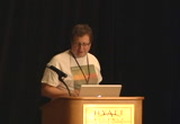Description
Using Python 3 to Build a Cloud Computing Service for my Superboard II
Presented by David Beazley
The OSI Superboard II was the computer on which I first learned to program back in 1979. Python is why programming remains fun today. In this tale of old meets new, I describe how I have used Python 3 to create a cloud computing service for my still-working Superboard--a problem complicated by it only having 8Kb of RAM and 300-baud cassette tape audio ports for I/O.
Abstract
Python 3, what good is it? Cloud computing? Bah! In this talk, I describe how I have used Python 3 to build a distributed cloud-computing service for my Superboard II system. Originally built in 1978, the Superboard is an obvious candidate for cloud computing due to its extremely constrained memory (8Kb), slow processor (a 1Mhz 6502), crippled I/O (300 baud over audio), and retro programming environment (Microsoft Basic 1.0). The only question is how to do it?
To answer that question, this talk consist of two main parts. In the first part, I discuss the problem of building a communications stack between the Superboard and a Mac using nothing but audio line-in/line-out ports--a problem involving a tricky I/O handling, real-time audio signal processing, and the creation of a data-link layer communication protocol. In the second part, I discuss the creation of a distributed cloud-computing service and related topics including messaging systems, key-value stores, map-reduce, etc.
The primary implementation language for all of this work is Python 3. Throughout the talk, I will mention interesting Python 3 programming idioms along with pros and cons. I'll conclude by summarizing my experience trying to build a significant project entirely in Python 3.


